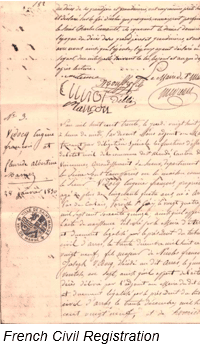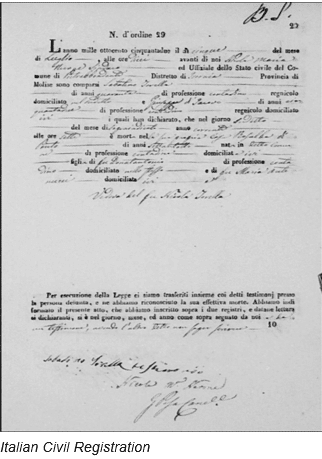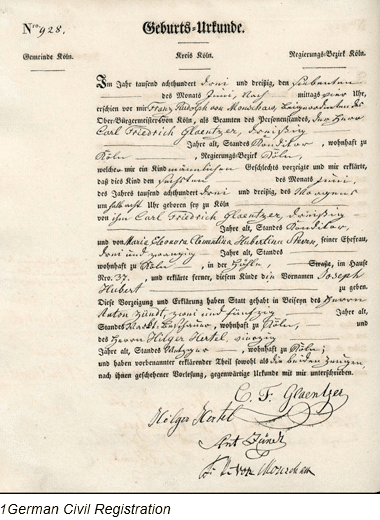Napoleonic Era Civil Registration – Part 2
 18
18Jun
Napoleonic Era Civil Registration
Regions
Under the French Republic, Civil Registration was introduced to France in 1792. As France expanded its imperial rule across much of Europe during the Napoleonic Wars (1803-1815), French officials implemented French civil law and code into its occupied territories. The Napoleonic Code was adopted by regions of Italy, regions of Germany, the Netherlands, Belgium, Poland, Spain, and Portugal, along with those nation’s respective colonial holdings. Thus, all of these regions adopted Napoleonic forms of civil registration for births, marriages, and deaths. Civil registration records for each of these regions will be discussed below.
France
 Civil authorities began registering births, marriages, and deaths in 1792, with universal coverage across France beginning at this date. Because these records cover all of the population, are indexed, are easily accessible, and include people from all denominations, they are an absolutely crucial source for French genealogical research. French civil registration records include registration for births, marriages, and deaths (each of these types were discussed in Part 1). Furthermore, divorce was permitted in France from 1792 to 1816, and after 1884. Divorce records were stored with civil registration records, and often the registrar would note the divorce in the margins of the divorced couple’s original marriage record. After 1877, the civil registrar gave a booklet to each couple he married. This booklet included an extract of the marriage record. The couple was responsible for taking the booklet to the registrar as each of their children were born, and the registrar would update the booklet with the child’s birth information and return the booklet to the parents. Deaths were also recorded in the booklet. Families kept possession of their family civil registration booklets and often handed them down to their children.
Civil authorities began registering births, marriages, and deaths in 1792, with universal coverage across France beginning at this date. Because these records cover all of the population, are indexed, are easily accessible, and include people from all denominations, they are an absolutely crucial source for French genealogical research. French civil registration records include registration for births, marriages, and deaths (each of these types were discussed in Part 1). Furthermore, divorce was permitted in France from 1792 to 1816, and after 1884. Divorce records were stored with civil registration records, and often the registrar would note the divorce in the margins of the divorced couple’s original marriage record. After 1877, the civil registrar gave a booklet to each couple he married. This booklet included an extract of the marriage record. The couple was responsible for taking the booklet to the registrar as each of their children were born, and the registrar would update the booklet with the child’s birth information and return the booklet to the parents. Deaths were also recorded in the booklet. Families kept possession of their family civil registration booklets and often handed them down to their children.
Civil registration has been kept in France ever since 1792. They are widely accessible on a variety of websites and by the FHL. To find your French ancestors in civil registration records, you must first determine the civil registration district your ancestor lived in. This is most likely the town that they lived in, though your ancestor may have lived in a village that belonged to a nearby larger town. In large cities there tended to be many civil registration districts. Gazetteers can be helpful in determining the civil registration district that your ancestor lived in. In addition, it is helpful to know the approximate year in which the birth, marriage, divorce, or death occurred. Records less than 100 years old are confidential, and cannot be accessed by the general public.
Websites and data sets with French civil registration records include:
- France Archives Etat civil en ligne
- MyHeritage, France, Compilation of Vital Records, 1585-1928
- MyHeritage, France, Nord Civil Deaths, 1820-1935
- MyHeritage, France Death Index, 1970-2020
The FHL also has microfilmed copies of some civil registration records. These can be found organized by region in the FamilySearch Catalog.
Italy
 The starting dates for civil registration varies from region to region in Italy. In 1799, Napoleon annexed large parts of Italy, including Roma, Venice, and the Piemonte region. Civil registration began in Italy under French occupation in 1804. As Napoleon’s rule in Italy expanded, he required civil registration in more and more regions. After Napoleon’s defeat in 1815, many regions discontinued civil registration. Civil registration was re-introduced in much of Italy in 1866 (and in 1871 in the Veneto region). The dates for civil registration are listed region by region below:
The starting dates for civil registration varies from region to region in Italy. In 1799, Napoleon annexed large parts of Italy, including Roma, Venice, and the Piemonte region. Civil registration began in Italy under French occupation in 1804. As Napoleon’s rule in Italy expanded, he required civil registration in more and more regions. After Napoleon’s defeat in 1815, many regions discontinued civil registration. Civil registration was re-introduced in much of Italy in 1866 (and in 1871 in the Veneto region). The dates for civil registration are listed region by region below:
- Papal States (including what is now Lazio, Umbria, Marche, and eastern Emilia-Romagna): Civil registration records were kept from 1810-1814 (during Napoleon’s rule), and resumed in 1866, after which they have been kept ever since.
- Veneto: Napoleonic civil registration records began in 1806, and ended in 1814 or 1815. Civil registration was resumed in this region in 1871, and has been kept ever since.
- Lombardy: Napoleonic civil registration records began in 1806, and ended in 1814 or 1815. Civil registration was resumed in this region in 1866, and has been kept ever since.
- Piemonte: Napoleonic records began in about 1804 and ended in 1814. They were re-introduced in 1866, and have been kept ever since.
- Ducato di Savoia, an area in Piemonte began keeping records again (after Napoleonic rule) in 1839.
- Sicilia: The island of Sicilia began civil registration in 1820 using a format nearly identical to the Napoleonic records.
- Regno di Napoli, Toscano, and the Abruzzo regions continued to keep civil registration records after Napoleon’s defeat. Thus, civil registration records exist in these regions from the early nineteenth century to the present.
- Sardinia and South Tyrol were never ruled by Napoleon, and thus never implemented civil registration during the early nineteenth century. Civil registration begins in this region in 1866.
Italian civil registration records consist of birth, marriage, and death records. Divorces were not allowed in Italy until 1970. Furthermore, a civil record unique to Italy is the Stato di famiglia, or state of the family certificate. The comune (a rough equivalent of a municipality or township) kept a record of each family within the comune, and updated each change, including births, marriages, deaths, and emigration. Historical states of the family are kept at the provincial archive, and document past generations of families. Annual and ten year indexes, organized alphabetically, are common in Italian registration records.
Most Italian civil registration records are available on FamilySearch. These can be accessed by looking at the FamilySearch catalog and the FamilySearch Wiki page for the locality you are researching. A comprehensive list of FamilySearch’s holdings for civil registration can be found here on a FamilySearch Wiki page.
Germany
Civil registration began in certain regions of Germany in 1792 under French rule, and became instigated nation-wide in 1876. Below lists the start dates for civil registration in Germany by region:
- Alsace-Lorraine: Civil registration started in 1792, since it belonged to France at the time, and have continued ever since.
- Hamburg, Hannover, Hessen, Lübeck, Oldenburg, and Westfalen established civil registration between 1799 and 1811 under Napoleonic rule. They discontinued civil registration after gaining independence from France, and civil registration wasn’t re-introduced until 1876, though Hamburg began keeping civil registration again in 1866.
 Anhalt began keeping civil registration in 1850.
Anhalt began keeping civil registration in 1850.- Prussia kept civil registration beginning in October 1874.
- Civil registration became mandatory in all German states on 1 January 1876.
German civil registration records include birth (geburtsregister), marriage (heiraten, ehen, or trauungen), and death (sterberegister) records. The first step in finding your German ancestors in civil registration records is to search for the town that your ancestor lived in on MeyersGaz.org to identify the location of the Standesamt, or the registry office. This is indicated by the abbreviation “StdA.” Upon identifying the location of the registry office, search for that locality in the FamilySearch Wiki and Catalog to determine record availability. Online records are listed on the FamilySearch Wiki page for each individual province.
Our examination of Napoleonic inspired civil registration will continue with part 3, coming soon. The experts at Price Genealogy can help you with your genealogy discoveries.
By Kaitlyn
Have you done any civil registration genealogy work yet? Let us know in a comment below!
